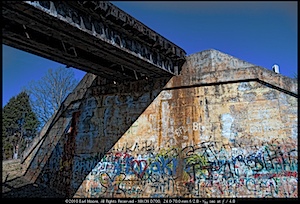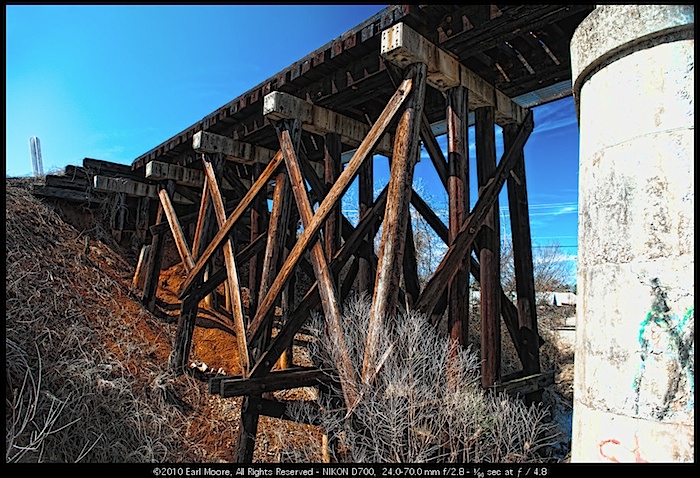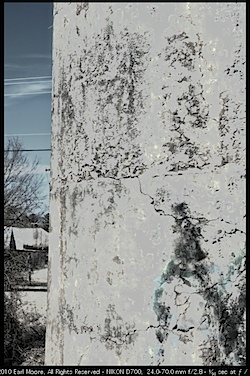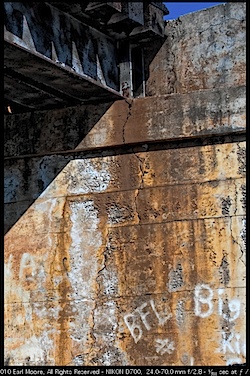I went for a drive in the countryside this past weekend and the above railroad trestle bridge caught my eye so I pulled over and walked back to the bridge to make a few photos. The shot above was one end of the bridge, then there was a two lane road passing under it and this next shot is the other end, complete with graffiti.

It was during post-processing I discovery a secondary story in these photos — prime examples of deterioration of the infrastructures. I’m not a structural engineer. but in the close-up clip below you’ll see what appears to be serious cracking in the supporting concrete structures on both ends of this railroad bridge.
The column, from the first photo, has multiple large “spider web” cracks which run around and across the structure. In some areas multiple cracks join — first photo below.
In the second photo below, the other end of the bridge, there are substantial cracks running down the supporting wall on each side of the iron i-beams. These cracks run from the ledge where the beams rest down about 2/3 the height of the wall.
I believe this bridge is only used for freight traffic and perhaps not too frequently. I would also suppose it’s being inspected regularly so perhaps these are only superficial cracks.
This situation is certainly not unique. If you look under many if not most older bridges you see as bad or worst examples of decay. I’ve seen a few bridges in my photography exploring that would make me have second thoughts about driving them.
There have been numerous news stories about the deterioration of bridges as well as other infrastructure structures, such as water pipes, subways and automobile tunnels. Where will the money come from to repair and replace all of this?
We seem to be continually patching the problems and only willing to replace those that actually fail. The rate of failure is only going to increase with time.



Hi Earl,
Love these photos, and the detail you captured. The coloring is stunning and I like the subjects. Thank you.
Alan
Alan, thanks for stopping by and commenting. I’m glad you like these photos.
Fine shots of this railroad bridge and the graffiti. You raise a good question about the condition of bridges all across the land and the lack of money with which to repair/replace them.
Don, I don’t know where the money will come from but when I think about the trillions of dollars we’ve spend in the wars in Iraq and Afghanistan I shake my head. It’s hard not to believe that could of been better used here.
This is a nice little project in a small area that produced a very nice result.
Don
Don and Sher, certainly one of those “unplanned projects.” But then those are often the best kind. ;-)
I remember that we had a garage floor that had somehow heaved in the middle. We had it replaced. Some months later, we saw a large crack in the floor. We called the engineer out and he said: The only thing that you can be sure about with concrete is that it is going to crack! He assured us that it was just fine and was just the nature of the beast.
You find most interesting things when you are out and about during your drives. I like to get to explore Salisbury and the surrounding areas ‘virtually’. BTW, those Singh-Ray filters are top of the line. I have two myself, the Vari-ND and the LB Polarizer. Both are great. Both are EXPENSIVE!
Paul, True, but driving under cracked concrete while a loaded freight train rubbles overhead makes those cracks all the more significant. ;-)
I’ve come to believe we’re all surrounded by interesting things it’s just up to us to find them and identify what makes them interesting. I like that photography motivates me and has taught me to view things this way.
Those Singh-Rays are expensive but I have to say it’s hard to argue with the quality and results.
Nice images, Earl. I had never heard of these Singh-Ray filters, good to know about them.
Interesting to hear about your concerns regarding the decay of the infrastructure, and the absence of funds to stop it. That’s what we use parts of our tax money, but there are of course prioritised work also here. That railway line seems not to be that busy. Either the case, I guess your close to the truth, that your tax money are being used for higher aims….
Ove, it’s not simply a concern of mine. The decay or crumbling of America’s infrastructure has been in the news for some time. During the 1900’s America experienced an unprecedented period of building and growth. Now many of these structures are reaching an age where they are starting to fail and will required substantial maintenance or replacement to extend their life and usefulness.
This far exceeds what the normal tax base can afford for normal maintenance.
Luckily, in part due to the economy, the number of air flights per day has actually decreased so an airport gridlock has not occurred.